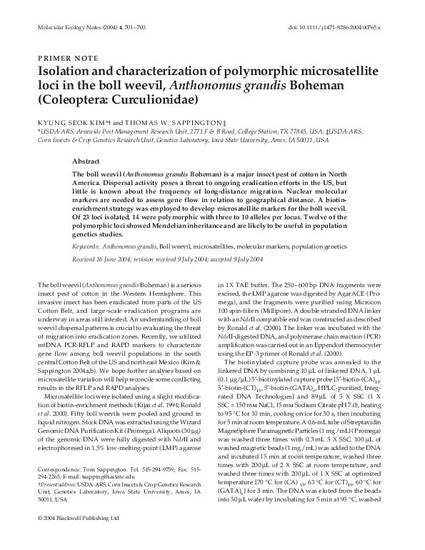
Article
Isolation and characterization of polymorphic microsatellite loci in the boll weevil, Anthonomus grandis Boheman (Coleoptera: Curculionidae)
Molecular Ecology Notes
Document Type
Article
Disciplines
Publication Date
12-1-2004
DOI
10.1111/j.1471-8286.2004.00765.x
Abstract
The boll weevil (Anthonomus grandis Boheman) is a major insect pest of cotton in North America. Dispersal activity poses a threat to ongoing eradication efforts in the US, but little is known about the frequency of long-distance migration. Nuclear molecular markers are needed to assess gene flow in relation to geographical distance. A biotin-enrichment strategy was employed to develop microsatellite markers for the boll weevil. Of 23 loci isolated, 14 were polymorphic with three to 10 alleles per locus. Twelve of the polymorphic loci showed Mendelian inheritance and are likely to be useful in population genetics studies.
Rights
Works produced by employees of the U.S. Government as part of their official duties are not copyrighted within the U.S. The content of this document is not copyrighted.
Language
en
File Format
application/pdf
Citation Information
Kyung Seok Kim and Thomas W. Sappington. "Isolation and characterization of polymorphic microsatellite loci in the boll weevil, Anthonomus grandis Boheman (Coleoptera: Curculionidae)" Molecular Ecology Notes Vol. 4 Iss. 4 (2004) p. 701 - 703 Available at: http://works.bepress.com/thomas_sappington/62/

This article is from Molecular Ecology Notes 4 (2004): 701, doi:10.1111/j.1471-8286.2004.00765.x.